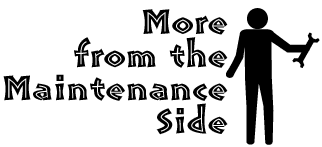 |
||||||||
| Issue Number 249 |
March
2000
|
|||||||
|
P.O. Box 189, Moffett Field, CA 94035-0189 |
||||||||
|
|
||||||||
 Air
Traffic Controllers are an integral part of most aviation operations,
but may sometimes lag flight crews in being informed about aircraft-specific
procedural changes. ASRS recently became aware of one such change affecting
Boeing 737 aircraft through the following pilot report:
Air
Traffic Controllers are an integral part of most aviation operations,
but may sometimes lag flight crews in being informed about aircraft-specific
procedural changes. ASRS recently became aware of one such change affecting
Boeing 737 aircraft through the following pilot report:
- Relatively
recently, as a result of the B-737 rudder problem, air maneuvering
speeds [for company B-737s] have been increased by as much as 20
knots. So a heavy B-737-400, e.g., 119,000 pounds, has a minimum
maneuvering speed of 180 knots, at flaps 10º. To fly any slower
would require that the landing gear be extended prior to any flap
setting greater than 10º of flap being selected (or the gear
warning sounds continuously and cannot be silenced).
Tonight, on being vectored for an ILS approach to Runway 36L, we were instructed to slow to 170 knots while more than 20 miles from the airport. We requested to maintain our minimum "clean," flaps-ups maneuvering speed of 230 knots (until within 20 miles of the airport). The controller acknowledged our request and vectored us farther out to allow for more spacing. Upon being turned over to the final approach controller, still 26 miles from the airport on a left base leg for Runway 36L, we were again instructed to slow to 170 knots. We advised the controller that our minimum maneuver speed would be 180 knots, until within 10 miles of the airport (the point at which it would be somewhat realistic to put the landing gear down, and then additional flaps, allowing a slower speed).
The controller could not understand why we did not wish to fly at 25 miles from the airport, with landing gear down at flaps 15º and 170 knots. It is important to note that there was a 22-knot tailwind on the approach, all the way down to 400 feet AGL.... No wonder that ATC had a 25-mile final approach course. We were at close to our maximum landing weight, too.
This was a major distraction [controller questioning] to me, and increased my workload. We did slow to 180 knots, 25 miles from the airport.... Pilot concurrence is required to slow below 210 knots when greater than 20 miles from the airport. I would much rather be taken out farther on a vector for spacing, or hold, than to have a jet transport, fully configured for landing more than 25 miles from the airport... I am recommending [that] an awareness program for ATC controllers be initiated regarding increased B-737 maneuver speeds, particularly at high aircraft gross weights.
In May 1999, following an industry/government evaluation, the Boeing Company issued recommended increases in maneuvering speeds for the B-737-100 through 500 series aircraft by means of Operations Manual Bulletin TBCE-11. The main effect of these changes was to increase aircraft maneuvering speeds 10 knots for approach and landing at flap settings UP through 10 degrees.
We hope our reporter’s heads-up about the revised B-737 maneuvering limits will help get the word out to the ATC community.
 Commercial
airline passengers are reminded during every preflight briefing to
turn off electronic devices that may interfere with aircraft systems
– including cell phones. Now here’s a report that suggests
what’s good for the cabin, is good for the cockpit, too.
Commercial
airline passengers are reminded during every preflight briefing to
turn off electronic devices that may interfere with aircraft systems
– including cell phones. Now here’s a report that suggests
what’s good for the cabin, is good for the cockpit, too.
- The
Captain filed the flight plan late so I could not pick up the clearance
until just before the passengers showed up. We were issued the SID
with transition. I did not have time to look up the SID because
the Captain was in a hurry to taxi out. He was making calls on a
cell phone while he taxied out so I still could not talk to him.
Tower put us in position and hold on Runway 30L while I yelled for
the Captain to turn off his cell phone. He finally did when they
cleared us for takeoff. We never did brief the takeoff or the SID.
Once airborne, the Captain asked me what we were supposed to do. I tried reading the text and gave him some of the instructions as I read them. I got confused at one point about how to join the transition and told the Captain. He turned the wrong way. ATC asked what radial we were trying to join... They told us to turn right to 140º to continue the SID and to call Approach once on the ground.
This would never have happened if the Captain had not been in such a hurry to get going, and if he had been paying attention to flying duties while taxiing out, instead of talking on his cell phone.…
We’re sure this type of event is rare, but it nonetheless illustrates the importance of effective cockpit management skills (and training). In effective CRM, flight crews make flying duties their first priority, and First Officers participate constructively in resolving problems.

ASRS continues to receive valuable safety suggestions from the maintenance community. We’d like to share a recent submission that highlights the importance of both visual and procedural "markers" for the completion of maintenance tasks.
- I
was assigned to perform the #9 A Check on the engine of an A-320.
I followed the job card procedures, which require the deactivation
of the hydraulic thrust reverser control unit by installing a safety
pin in the control unit. While I continued with the engine service,
I found a couple of discrepancies that would need to be addressed...
As time passed, it was near to push-out and run the engines for
leak checks. It was at this point I became rushed and missed reactivating
the thrust reverser hydraulic control unit...
I did not realize my mistake until I was on my way home and the aircraft was already airborne. At once I called the station maintenance controller and explained the problem... I learned the next day that the aircraft landed safety at its destination, but that the #1 engine thrust reverser did not deploy, resulting in diminished stopping capability.
Aside from obviously paying more attention to my work, it would have been helpful if a remove-before-flight streamer was installed on the deactivation pin of the control unit. I would likely have seen the streamer prior to closing the fan cowls.
ASRS learned in a callback to this reporter that he had followed maintenance instructions on a job card for the thrust reverser lockout procedure. The job card directed the technician to install the lockout pin on the reverser, but did not direct removal of the pin – instead, it instructed the technician to "restore aircraft to normal." Nor did it require an operational check of the thrust reverser. The absence of explicit instructions for completing the job deprived the technician of a memory jogger that apparently was much needed in the time-pressure situation involved.
 In the dawning era of electronic flight bags, computerized aircraft
logs, and datalink communications, let’s not forget the plight
of the pilot who must maintain paper logs, charts, and documentation.
An example is this ASRS reporter who described "an off-runway
altercation with an intersection marker," and the chilling aftermath:
In the dawning era of electronic flight bags, computerized aircraft
logs, and datalink communications, let’s not forget the plight
of the pilot who must maintain paper logs, charts, and documentation.
An example is this ASRS reporter who described "an off-runway
altercation with an intersection marker," and the chilling aftermath:
- I
have discovered that my airplane is in violation of FAR Part 91.411/413
– the altimeter and transponder tests. The FAA is investigating
and wants to see my maintenance logs. The problem isn’t that
I missed by a few weeks or months. As I paged through the history
of the plane, I saw an old entry for the test and a chill went through
my body. This FAR has been off my mental checklist for years!!
My insurance company inquires annually as to when my medical is due. The same [principle] goes for Biennial Flight Reviews. It is hard to miss the ELT battery because the annual inspection requires that it be good through the next year. These other scheduled responsibilities have a backup memory jogger. This one just faded from my mind and didn’t resurface until I had this occasion to be thoughtfully paging through the plane’s history.
I keep a log sheet in the plane to track engine/airframe time on a per flight basis. As the bottom of that sheet, I have blanks for "Next oil change due ___" and "VOR test: date, place, initials." A transponder due date blank will be added to that sheet.…
![]() A
student pilot is now more aware of certificate limitations and the
importance of verifying log entries, following multiple FAR violations
related to an annual aircraft inspection:
A
student pilot is now more aware of certificate limitations and the
importance of verifying log entries, following multiple FAR violations
related to an annual aircraft inspection:
- I flew as a student pilot-PIC with the mechanic who had just completed my Annual Inspection. I recently learned that the mechanic is not a licensed pilot, and as such was a passenger on this test flight. Ten days later I returned to pick up the plane. The mechanic said to take the plane and he would forward the logs later. I now realize that I violated FARs again by not inspecting and verifying that correct entries had been made in the logs prior to my return trip. I understand I should have obtained at least a Ferry Permit.

And a geography lesson from a veteran pilot who explains how he became lost on the paper trail.
- This
may be the only time an incident occurred because of over-preparation.
Rushed takeoff. Had WAC charts, sectionals and IFR charts all over the cockpit. Simply missed noticing that route neared Kansas City Class B airspace.
By way of explanation, I must confess that I thought Kansas City was in Kansas, not Missouri. So, heading into Kansas, I didn’t notice the Class B data on any of my charts. When the event was called to my attention, the data regarding the airspace was found – in the corners of charts that I had already put away.
|
|
|---|
| A discrepancy in deferral of ATR-42 MEL items |
| Airborne conflicts in a Caribbean holding pattern |
| B737-200 uncommanded rudder movement incident |
| Passenger stratagems for disabling lav smoke detectors |
| B737-400 maneuvering speed limitations in Terminal Area |
|
|
|
|---|---|
|
Air
Carrier/Air Taxi Pilots
|
2,010
|
|
General
Aviation Pilots
|
481
|
|
Controllers
|
64
|
|
Cabin/Mechanics/Military/Other
|
170
|
|
TOTAL
|
2,725
|